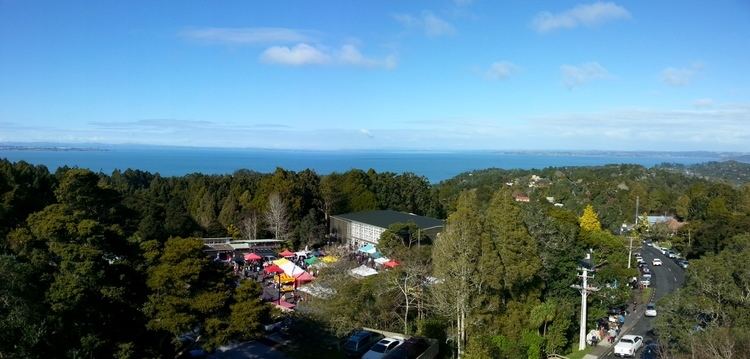Population 3,330 (2006) Southeast Wood Bay Road | Northeast Titirangi North | |
 | ||
Titirangi is a suburb in the Waitakere Ward of the city of Auckland in northern New Zealand. It is an affluent, residential suburb located 13 kilometres to the southwest of the Auckland city centre, at the southern end of the Waitakere Ranges. In Māori language "Titirangi" means "long streaks of cloud in the sky", but this is often given as "fringe of heaven".
Contents
Map of Titirangi, Auckland 0604, New Zealand
The population was 3,330 in the 2006 Census, an increase of 93 from 2001.
It is characterised by houses built within the native bush of the Waitakere Ranges. Many are of unusual design or are raised on poles to avoid the damp. The Waitakere Ranges lie on the west coast in the path of the prevailing winds from the Tasman and consequently attract a high rainfall. The native bush is home to many native birds, such as the fantail, tui, kererū or "wood pigeon", morepork and white-eye. The landscape of Titirangi ranges from Titirangi Beach on the Manukau Harbour to 400 metre high parts of the Waitakere Ranges.
For a long time the area had a reputation for bohemianism. A number of well known New Zealand musicians, artists, writers and potters currently live or have lived in the area, including singer/songwriter Tim Finn (who wrote the song "I Hope I Never" there), actress Alma Evans-Freake, author Maurice Shadbolt, painter Colin McCahon (whose house is preserved as a museum), photographer Brian Brake, poet John Caselberg, photographer James Stonley and potter Len Castle. An active local theatre, community art gallery and radio station are based in historic Lopdell House. Located next door, Te Uru Waitakere Contemporary Gallery is West Auckland's regional art gallery. Many short walks or tramps in the Waitakeres start from Titirangi.
Titirangi is bordered to the south by Manukau Harbour, to the west and north west by the rest of the Waitakere Ranges' native bush clad hills consisting of the large Centennial Memorial Park and water catchment areas which supply much of Auckland's water. The main road into the Waitakeres, the Scenic Drive, begins in Titirangi. To the east and north are a number of more urban suburbs. For many New Zealanders, the name "Titirangi" is associated with Auckland's best-known golf course, the Titirangi Golf Course. The course is actually located on the border of the nearby suburbs of New Lynn and Green Bay. Other suburbs surrounding Titirangi include Waima, Konini, Glen Eden, Woodlands Park, Laingholm and Waiatarua.
Education
Titirangi School is a coeducational contributing primary (years 1-6) school with a decile rating of 10 and a roll of 506 . The school celebrated its centenary in 1972 although the history of the school goes back to around 1845.
The nearest state secondary schools are Green Bay High School, Kelston Boys' High School and Kelston Girls' High School.
Monuments
The sculpture on the round-about connecting Titirangi Road, Atkinson Road, Kohu Road, Scenic Drive and Huia Rd has been a symbol of Titirangi for many years, although it is a controversial presence, not popular with everyone. Designed by student artist-jeweller Lisa Higgens in 1993, it was originally erected with the intention of only being in place for five years but has remained permanently. Its original pink colour was toned down to a teal green in 2009.
